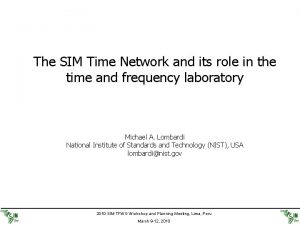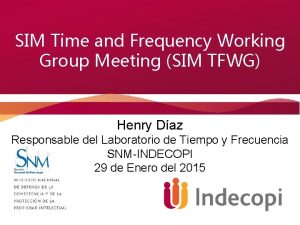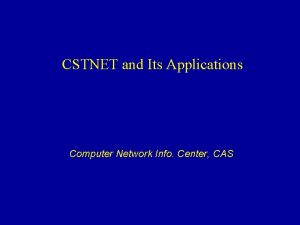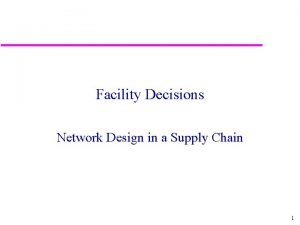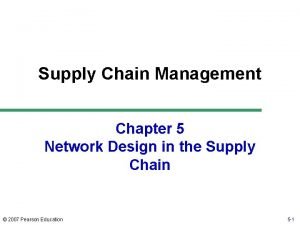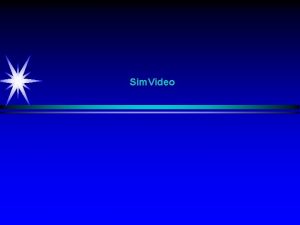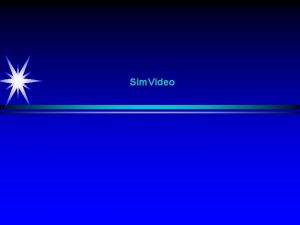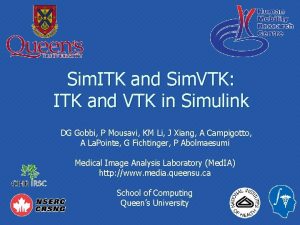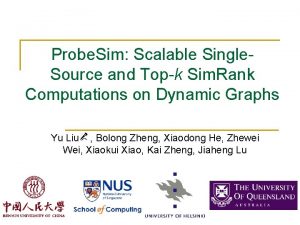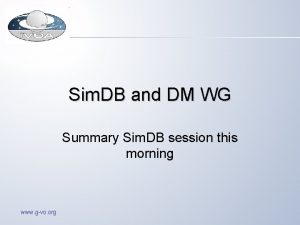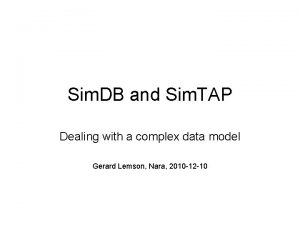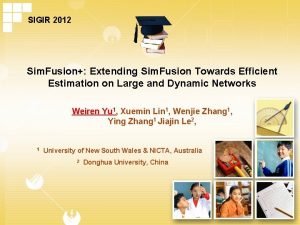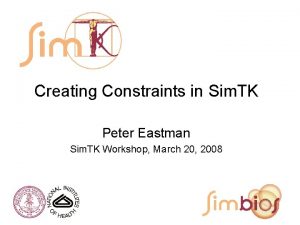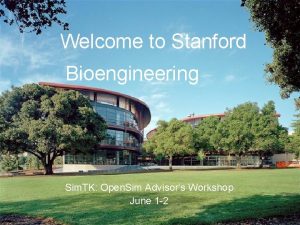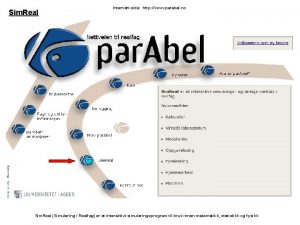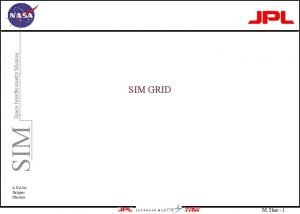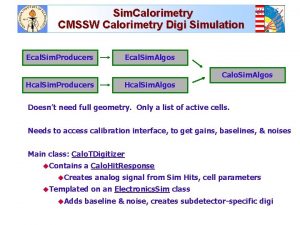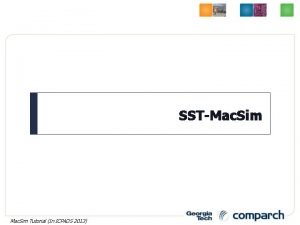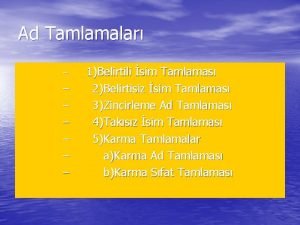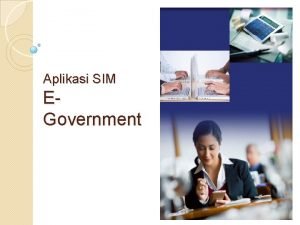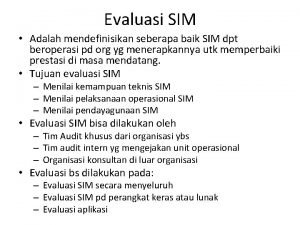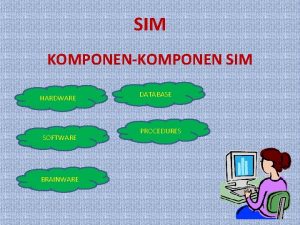The SIM Time Network and its role in





























































- Slides: 61

The SIM Time Network and its role in the time and frequency laboratory Michael A. Lombardi National Institute of Standards and Technology (NIST), USA lombardi@nist. gov 2010 SIM TFWG Workshop and Planning Meeting, Lima, Peru March 9 -12, 2010

SIM is the Interamerican Metrology System, one of the world’s five major Regional Metrology Organizations (RMOs) recognized by the BIPM 2010 SIM TFWG Workshop and Planning Meeting, Lima, Peru March 9 -12, 2010

The purpose of RMOs n The International Bureau of Weights and Measures (BIPM) works to ensure the worldwide uniformity of measurements and their traceability to the International System of Units (SI). This allows the measurements made in one country to be accepted and trusted in other countries, which is important for international trade. n The BIPM expects RMOs to review the quality systems of NMIs, and their calibration and measurement capabilities (CMCs). RMOs should also: u Organize regional comparisons to supplement the BIPM key comparisons so that more nations can establish traceability to the SI. This is the role of the SIMTN. 2010 SIM TFWG Workshop and Planning Meeting, Lima, Peru March 9 -12, 2010

Information about SIM n SIM consists of NMIs located in the 34 member nations of the Organization of American States (OAS), which extends throughout North, Central, and South America, and the Caribbean region. n OAS accounts for roughly 13% of the world’s population (about 910 million people as of 2009), and roughly 27% of its land mass. SIM is the largest RMO in terms of land area. n About 2 out of 3 people in the SIM region live in the United States, Brazil, or Mexico (roughly 617 million people). n Eleven SIM nations (mostly islands) have less than 1 million people. n SIM has organized metrology working groups (MWGs) in 11 different areas, including time and frequency. The SIM Time Network is operated by the T&F MWG. 2010 SIM TFWG Workshop and Planning Meeting, Lima, Peru March 9 -12, 2010

SIM Time Network Design Goals n Our design goals were: u To establish cooperation and communication between the SIM time and frequency labs now and in the future. u To build a network that allowed all SIM NMIs to compare their time standards to those of the rest of the world. u To utilize equipment that was low cost and easy to install, operate, and use, because SIM NMIs typically have small staffs and limited resources. u To be capable of measuring the best standards in the SIM region. This meant that the measurement uncertainties had to be as small, or nearly as small, as those of the BIPM key comparisons. u To report measurement results in near real-time, without the processing delays of the BIPM key comparisons. u To build a democratic network that favored no single laboratory or nation, and to allow all members to view the results of all comparisons. 2010 SIM TFWG Workshop and Planning Meeting, Lima, Peru March 9 -12, 2010

TIME AND FREQUENCY METROLOGY WORKING GROUP Working to support time and frequency metrology throughout the Americas United States, 2005 Mexico, 2005 Canada, 2005 Panama, 2005 Brazil, 2006 Costa Rica, 2007 Colombia, 2007 Argentina, 2007 Guatemala, 2007 Jamaica, 2007 Uruguay, 2008 Paraguay, 2008 Peru, 2009 Trididad & Tobago, 2009 Chile, 2010 Saint Lucia, 2010 SIM TFWG Workshop and Planning Meeting, Lima, Peru March 9 -12, 2010

2010 SIM TFWG Workshop and Planning Meeting, Lima, Peru March 9 -12, 2010

Country Date equipment was shipped BIPM MRA Signatory? T&F Standard Contributes to UTC? United States 2005 Yes Time Scale (six masers and four cesiums) and Primary Standard Yes Mexico 04/2005 Yes Time Scale (one maser and four cesiums) Yes Canada 05/2005 Yes Time Scale (three masers and four cesiums) Yes Panama 10/2005 Yes Two cesiums Yes Brazil 09/2006 Yes Time Scale (six cesiums) Yes Costa Rica 01/2007 Yes Cesium No Colombia 02/2007 No Two cesiums No Argentina 07/2007 Yes Cesium Yes Guatemala 08/2007 No GPSDO No Jamaica 12/2007 Yes Two cesiums No Uruguay 11/2008 Yes Disciplined rubidium No Paraguay 11/2008 Yes Rubidium No Peru 06/2009 Yes Rubidium No Trinidad / Tobago 08/2009 Yes GPSDO No Chile 2010 Yes Rubidium? NMI does not, but geodetic observatory does Saint Lucia 2010 Yes Rubidium? No 2010 SIM TFWG Workshop and Planning Meeting, Lima, Peru March 9 -12, 2010

The SIM Measurement System n Simple design makes it easy and inexpensive for SIM labs to compare their standards. It includes: u 8 -channel GPS receiver (C/A code, L 1 band) u Time interval counter with 30 ps resolution u Rack-mount PC and flat panel display u Pinwheel type antenna u Applies broadcast ionospheric (MDIO) corrections n Data are not stored in CGGTTS format. The receiver measures all visible satellites and stores 1 -minute and 10 -minute REFGPS averages. n All systems are connected to the Internet, and send their files to a web server every 10 minutes. n The web server processes data “on the fly” in near real-time. Results can be viewed on the web in either common-view or all-in-view format. n All units are built and calibrated at NIST n Systems are paid for by either OAS or the participating NMI and become the property of the NMI. 2010 SIM TFWG Workshop and Planning Meeting, Lima, Peru March 9 -12, 2010

tf. nist. gov/sim 2010 SIM TFWG Workshop and Planning Meeting, Lima, Peru March 9 -12, 2010

2010 SIM TFWG Workshop and Planning Meeting, Lima, Peru March 9 -12, 2010

2010 SIM TFWG Workshop and Planning Meeting, Lima, Peru March 9 -12, 2010

Reporting results to participating SIM laboratories n Measurement results can be viewed using any Java-enabled web browser. Our web-based software does the following: u Plots the one-way GPS data (average of all satellites and tracks for each individual satellite) as recorded at each site relative to the local standard. u Plots the time and frequency difference between NMIs using the commonview method (common-view data are averaged across all satellites and are also shown for each individual satellite). u Calculates the Allan deviation and time deviation. u Makes 10 minute, 1 hour, and 1 day averages available in tabular form. u Up to 200 days of data can be retrieved at once. All old data remains available, nothing is ever deleted. u The time difference between any two laboratories can be viewed by all laboratories in the network. New results are available every 10 minutes. u Results can be processed as “classic” common-view or all-in-view. 2010 SIM TFWG Workshop and Planning Meeting, Lima, Peru March 9 -12, 2010

2010 SIM TFWG Workshop and Planning Meeting, Lima, Peru March 9 -12, 2010

2010 SIM TFWG Workshop and Planning Meeting, Lima, Peru March 9 -12, 2010

2010 SIM TFWG Workshop and Planning Meeting, Lima, Peru March 9 -12, 2010

2010 SIM TFWG Workshop and Planning Meeting, Lima, Peru March 9 -12, 2010

2010 SIM TFWG Workshop and Planning Meeting, Lima, Peru March 9 -12, 2010

Maximum Time Difference last 6 months of 2009 NIST CENAM NRC CNM 57 -57 NRC CNMP ONRJ ICE SIC -95 38 25 -1066 -56 52 51 -111 -81 -38 -1081 -74 68 -80 122 93 -997 118 133 138 -59 -1088 -88 57 56 -1084 -46 61 68 1032 1072 1098 79 100 95 111 CENAMEP -38 81 -122 ONRJ -25 38 -93 59 ICE 1066 1081 997 1088 1084 SIC 56 74 -118 88 46 -1032 INTI -52 -68 -133 -57 -61 -1072 -79 BSJ -51 80 -138 -56 -68 -1098 -100 2010 SIM TFWG Workshop and Planning Meeting, Lima, Peru March 9 -12, 2010 INTI BSJ -71 71

Average Time Difference last 6 months of 2009 NIST CENAM NRC CNM 10 -10 NRC CNMP ONRJ ICE SIC -73 13 <1 -480 -8 15 11 -82 4 -9 -489 -18 3 <1 86 71 -407 65 86 84 -17 -492 -21 -7 -2 -476 -6 11 13 456 487 464 16 18 73 82 CENAMEP -13 -4 -86 ONRJ <1 9 -71 17 ICE 480 489 407 492 476 SIC 8 18 -65 21 6 -456 INTI -15 -3 -86 7 -11 -487 -16 BSJ -11 <1 -84 2 -13 -464 -18 2010 SIM TFWG Workshop and Planning Meeting, Lima, Peru March 9 -12, 2010 INTI BSJ 4 -4

Average Frequency Difference (× 1015) last 6 months of 2009 NIST CNM NIST -4 NRC CNMP ONRJ ICE SIC INTI -2 3 -2 15 -1 <1 1 2 6 2 19 2 4 5 5 <1 17 <1 2 4 -5 13 -4 -3 -1 17 <1 2 4 -21 -15 -28 2 3 CENAM 4 NRC 2 -2 -3 -6 -5 2 -2 <1 5 ICE -15 -19 -17 -13 -17 SIC 1 -2 <1 4 <1 21 INTI <1 -4 -2 3 -2 15 -2 BSJ -1 -5 -4 1 -4 28 -3 CENAMEP ONRJ BSJ 2010 SIM TFWG Workshop and Planning Meeting, Lima, Peru March 9 -12, 2010 2 -2

Benefits to the SIM Region n Improved time coordination. n Better time standards are being maintained at many of the SIM labs. n Increased awareness of the importance of time and frequency. u n Improved status for NMIs. u n Some SIM labs are introducing new calibration services and improving existing services to better support local industry. New time services are also being introduced (NTP servers, web clocks, etc. ). Companies in SIM countries are likely to use their local NMI as a source of traceable frequency measurements. A more visible official timekeeper. u Some SIM labs have become or are trying to become the official timekeepers in their countries. 2010 SIM TFWG Workshop and Planning Meeting, Lima, Peru March 9 -12, 2010

2010 SIM TFWG Workshop and Planning Meeting, Lima, Peru March 9 -12, 2010

Selecting a Time and Frequency Standard: Rubidium, Cesium, GPSDO, or ensemble time scale 2010 SIM TFWG Workshop and Planning Meeting, Lima, Peru March 9 -12, 2010

Choices in Frequency Standards n Cesium Oscillators u Used to define the second, one of the seven base units of the SI u A true intrinsic standard u Costly, probably $35 000 to $75 000 USD n Rubidium Oscillators u Low cost (often under $5 000 USD) but need to be adjusted often to compensate for aging and frequency drift n GPS Disciplined Oscillators u A quartz or rubidium oscillator continuously steered to agree with signals from the GPS satellites. Cannot be adjusted, but doesn’t need it. u Price ranges from about $1 000 to $15 000 USD u Are they an acceptable choice as a primary frequency standard? 2010 SIM TFWG Workshop and Planning Meeting, Lima, Peru March 9 -12, 2010

Rubidium Oscillators n The least expensive atomic oscillator n Typically costs about 1/10 as much as a cesium, but its unadjusted accuracy is typically about 1000 times worse u $3, 500 rubidium might be accurate to a few parts in 1010 after warm up u $35, 000 cesium is likely to be accurate to within a few parts in 1013 n They need to be adjusted periodically u Frequency change (due to aging) can exceed 1 x 10 -11 per month, or 1 x 10 -10 per year n Not acceptable for BIPM key comparisons 2010 SIM TFWG Workshop and Planning Meeting, Lima, Peru March 9 -12, 2010

2010 SIM TFWG Workshop and Planning Meeting, Lima, Peru March 9 -12, 2010

Cesium Oscillators n A true primary standard for a cal lab, since the SI second is defined based on cesium n Maintenance cost is high, since the beam tube (which is often more than half the cost of the oscillator) typically needs replacement after about 10 years n Can operate for many weeks, months, or years without requiring adjustment, maintaining average frequency of less than 1 × 10 -13 if properly maintained. n Still needs to be checked against a secondary standard to make sure that it is working - a failed cesium becomes an OCXO. 2010 SIM TFWG Workshop and Planning Meeting, Lima, Peru March 9 -12, 2010

2010 SIM TFWG Workshop and Planning Meeting, Lima, Peru March 9 -12, 2010

GPS Disciplined Oscillators (GPSDO) n A self-calibrating standard n Care must be taken to ensure that GPS signals are being received and that the GPSDO is working properly n Performance varies, but even the worst units will be accurate to better than 1 × 10 -12 over a one day interval n Great performance for the money, but not adjustable and not accepted in BIPM key comparisons n A good thing to have, however, as a backup or secondary standard 2010 SIM TFWG Workshop and Planning Meeting, Lima, Peru March 9 -12, 2010

2010 SIM TFWG Workshop and Planning Meeting, Lima, Peru March 9 -12, 2010

2010 SIM TFWG Workshop and Planning Meeting, Lima, Peru March 9 -12, 2010

Ensemble Time Scales n Require multiple cesium oscillators. n Very expensive, but a time scale will be more stable than any of its individual clocks. It will also keep going if one of the clocks fails. n Requires measurement hardware, phase steppers, synthesizers, etc. n CENAM, NIST, NRC, and ONRJ now have ensemble time scales and can help other SIM labs that want to start one. 2010 SIM TFWG Workshop and Planning Meeting, Lima, Peru March 9 -12, 2010

UTC(NIST) Time Scale The NIST Time Scale consists of an ensemble of commercial clocks, currently six hydrogen masers and four cesium beam standards. The weighted average of these clocks generates continuous signals from a high resolution frequency synthesizer that is locked to a hydrogen maser. Both 5 MHz (frequency) and 1 pps (time) signals are generated. The clock ensemble is periodically calibrated using the NIST-F 1 primary standard. Of course, a time scale can be built with fewer clocks and without hydrogen masers. . However, at least three cesiums are required. The time scales at CENAM and ONRJ have built or redesigned in recent years and provide excellent performance. 2010 SIM TFWG Workshop and Planning Meeting, Lima, Peru March 9 -12, 2010

Selecting Measurement Equipment 2010 SIM TFWG Workshop and Planning Meeting, Lima, Peru March 9 -12, 2010

2010 SIM TFWG Workshop and Planning Meeting, Lima, Peru March 9 -12, 2010

Essential Equipment for a Frequency Measurement Laboratory n Essential Equipment § § § Primary Frequency Standard Secondary Frequency Standard (if you don’t have a multi-clock time scale) Distribution Amplifier Oscilloscope Universal Counter Signal Generator 2010 SIM TFWG Workshop and Planning Meeting, Lima, Peru March 9 -12, 2010

Distribution Amplifier n The frequency signals (typically 10 MHz sine waves) from the lab’s primary standard can be distributed throughout the work area using a distribution amplifier. n Signals from the distribution amplifier should be used as the external time base for all instrumentation in the laboratory (counters and signal generators, for example). This will ensure that the lab’s measuring instruments have the same frequency accuracy as the primary standard. 2010 SIM TFWG Workshop and Planning Meeting, Lima, Peru March 9 -12, 2010

Oscilloscope n n Allows the viewing of waveforms and pulses, an indispensable device for the time and frequency lab. Can be used to measure frequency, but that should only be done if a counter is not available. 2010 SIM TFWG Workshop and Planning Meeting, Lima, Peru March 9 -12, 2010

Key Oscilloscope Specifications n n n Bandwidth u 20 MHz (low end) to 70 GHz (high end) u A 100 MHz unit is adequate for a timing lab Time base range u Best scopes can scale from about 50 ps to 50 s per division (10 divisions) u A unit that scales from 5 ns to 50 s per division is adequate for a timing lab Frequency Counter Resolution u Typically about 1 x 10 -4 (1 k. Hz resolution at 10 MHz), not useful for any serious measurement, but provides quick check of frequency Time Interval Resolution u Proportional to length of the interval u Typically about 1 x 10 -4 ( 1 µs for 10 ms interval) Number of channels u Ranges from 2 to 8 plus external trigger u 2 channel handles pattern drift method t function is very useful for time interval measurements 2010 SIM TFWG Workshop and Planning Meeting, Lima, Peru March 9 -12, 2010

Universal Counter n n Counts frequency, time interval, period, and events (totalize mode). Some universal counters include other functions like phase, peak voltage, rise/fall time, etc. Probably the most important instrument in a time and frequency lab, useful in nearly all areas of T&F metrology. 2010 SIM TFWG Workshop and Planning Meeting, Lima, Peru March 9 -12, 2010

Universal Counter Specs (Frequency) n Frequency Range u 100 MHz (low end) to 50 GHz (high end) u For most purposes, a unit that can count up to 100 MHz is adequate. n Resolution (number of digits) u 7 digits ($200 counters) to 13 digits u 8 -digit counter has 1 Hz resolution at 10 MHz: Ø 10 000 Hz Ø This allows it to detect frequency changes as small as 1 x 10 -7 u 12 -digit counter has 100 µs resolution at 10 MHz: Ø 10 000 000 0 Hz Ø This allows it to detect frequency changes as small as 1 x 10 -11 Ø 12 -digit counters are relatively cheap, and recommended n Any selected counter must be able to accept an external time base. 2010 SIM TFWG Workshop and Planning Meeting, Lima, Peru March 9 -12, 2010

Universal Counter Specs (Time Interval) n Time Interval Resolution u 100 ns (low end, period of 10 MHz time base) to 20 ps (high end) u Relatively low cost counters have 150 ps resolution, which is more than adequate. Smallest frequency offset which can be resolved at 1 second is 150 ps / 1 second, or 1. 5 x 10 -10. n Time Interval Accuracy and Range u Typically, no better than 1 ns for even the best counters, but it is not proportional to the length of the interval like it is for oscilloscopes. u A good counter can measure intervals from 1 ns to about 100 000 seconds. The best oscilloscopes can measure shorter intervals, but it is unlikely that cal labs will need to do this. 2010 SIM TFWG Workshop and Planning Meeting, Lima, Peru March 9 -12, 2010

Signal Generator n Generates signals at user selectable frequencies and amplitudes u Some units (called function generators) generate a variety of different waveforms, other units generate just sinewaves and/or squarewaves 2010 SIM TFWG Workshop and Planning Meeting, Lima, Peru March 9 -12, 2010

Signal Generator Uses n Extremely useful tool for generating signals to test measurement systems. Also useful for repairing equipment. u Can generate frequencies with small offsets from nominal u Can generate a needed frequency locked to house reference, when no standalone oscillator exists u Can generate test signals needed to calibrate stopwatch calibrator or other systems 2010 SIM TFWG Workshop and Planning Meeting, Lima, Peru March 9 -12, 2010

Key Signal Generator Specifications n n Frequency Range u 1 MHz or less (low end) to 100 GHz or more (high end) u A device that goes a little above 10 MHz is adequate. Amplitude Range u 0. 01 to 10 V peak-to-peak (50 ohms) is typical and will handle most lab functions Resolution u Resolution tends to be lower on devices with the largest frequency range, for example a device that goes to 1 GHz probably will only have 1 or 10 Hz resolution. u 1 µHz resolution is about as good as it gets, and is desirable for cal lab purposes. It allows generating a 10 MHz signal with a 1 x 10 -13 frequency offset. Some units extend 1 µHz resolution out to about 80 MHz. With a unit like that you can generate a signal with a 1. 25 x 10 -14 frequency offset. External time base is mandatory 2010 SIM TFWG Workshop and Planning Meeting, Lima, Peru March 9 -12, 2010

Optional Equipment for a Frequency Measurement Laboratory (recommended for most labs) n Optional Equipment § § An automated phase comparison system § § § Homebrew (PC and time interval counter, for example) Commercially available phase comparator (heterodyne system, for example) NIST Frequency Measurement System Frequency Dividers and Multipliers A stopwatch calibrator Data Analysis Software (homebrew, Stable 32, Excel, etc. ) 2010 SIM TFWG Workshop and Planning Meeting, Lima, Peru March 9 -12, 2010

Basic Model of a Phase Comparator for Measuring Frequency Device Under Test Reference Frequency f f 0 Comparator Oscilloscope, frequency counter, time interval counter, Dual Mixer Time Difference System PC Data Acquisition System 2010 SIM TFWG Workshop and Planning Meeting, Lima, Peru March 9 -12, 2010

Homebrew System n Several types of systems are possible, but the most practical would probably consist of a time interval counter, a PC, and software u Software must be written to collect a series of measurements from the counter (Basic, C, Labview, etc. ) u Data can be analyzed using your own software, Stable 32, or Excel. You can download Francisco’s software for free from the SIM web site. u Frequency dividers must be built or purchased to divide the standard reference and DUT signals to a common low frequency, usually 1 Hz 2010 SIM TFWG Workshop and Planning Meeting, Lima, Peru March 9 -12, 2010

Time Interval Method 2010 SIM TFWG Workshop and Planning Meeting, Lima, Peru March 9 -12, 2010

Dual-Mixer Time Difference System (DMTD) 2010 SIM TFWG Workshop and Planning Meeting, Lima, Peru March 9 -12, 2010

Commercial DMTD System n Measures frequencies from 1 MHz to 20 MHz n Computes Allan deviations from 0. 01 s to 106 s n Produces phase and frequency plots n Resolution is about 100 femtoseconds (0. 1 ps), about 200 times better than the best time interval counters. 2010 SIM TFWG Workshop and Planning Meeting, Lima, Peru March 9 -12, 2010

Stopwatch Calibrator n A handy instrument to have if you laboratory calibrates stop watches and timers n Several models are available, costing between about $2, 000 and $3, 500 n They reduce the time required to perform calibrations 2010 SIM TFWG Workshop and Planning Meeting, Lima, Peru March 9 -12, 2010

2010 SIM TFWG Workshop and Planning Meeting, Lima, Peru March 9 -12, 2010

Software n The laboratory should have software available to perform basic time and frequency functions, such as: u u n Estimate average frequency accuracy from phase data Compute Allan deviation Produce graphs for calibration reports Perform uncertainty analysis Software can written in-house with any programming language and many functions are easy enough to automate with Excel. One commercially available software package is Stable 32 (www. stable 32. com). The free software written by Francisco Jimenez can be downloaded here: http: //tf. nist. gov/sim/papers. htm 2010 SIM TFWG Workshop and Planning Meeting, Lima, Peru March 9 -12, 2010

Joining the BIPM key comparisons 2010 SIM TFWG Workshop and Planning Meeting, Lima, Peru March 9 -12, 2010

The SIM Time Network collects more data than the CGGTTS* format used by the BIPM, but is not compatible § Simple format collects more data without the need for a tracking schedule. Method Tracks per day Track Length Satellites Minutes of data per day CGGTTS * single-channel 48 13 1 624 CGGTTS * multi-channel 90 13 8 typical 9360 SIM 144 10 8 maximum 11520 * Consultative GPS and GLONASS Time Transfer Sub-committee 2010 SIM TFWG Workshop and Planning Meeting, Lima, Peru March 9 -12, 2010

The CGGTTS Common-view Data Format GPS RCVR: NBS 10 V 9809 MJD= 51658 YR=00 MONTH=04 DAY=24 HMS=14: 47: 20 (UT) GGTTS GPS DATA FORMAT VERSION = 01 REV DATE = 2000 -04 -03 RCVR = NBS 10. . . . . CH = 01 IMS = 99999 LAB = NIST X = -1288398. 27 m Y = -4721698. 10 m Z = +4078625. 68 m FRAME = ITRF. . COMMENTS = NO COMMENTS. . . INT DLY = 53. 0 ns CAB DLY = 0199. 9 ns REF DLY = 0066. 7 ns REF = UTCNIST CKSUM = 74 PRN CL MJD STTIME TRKL ELV AZTH REFSV SRSV REFGPS SRGPS DSG IOE MDTR SMDT MDIO SMDI CK hhmmss s . 1 dg . 1 ns . 1 ps/s. 1 ns . 1 ns. 1 ps/s 3 08 51655 105800 780 380 760 -1058301 -1131 -571 -1098 415 163 107 +2 76 +0 02 8 32 51655 111400 780 319 2933 -7071115 -3061 -246 -3082 290 074 125 -20 85 -9 34 13 28 51655 113000 780 415 3083 +6965884 -30 -94 -241 625 019 100 -12 71 -7 FB 3 74 51655 114600 780 296 530 -1058331 +929 -503 +962 470 163 133 +19 92 +24 17 31 08 51655 121800 780 498 706 -7572 -400 -197 -390 470 180 87 +4 99 +14 DD 13 32 51655 123400 780 569 2693 +6966345 +171 -440 -40 424 011 79 +0 90 +9 F 0 18 68 51655 125000 780 279 1829 -341335 +18 -132 +22 698 182 141 +35 152 +44 16 31 74 51655 132200 780 283 472 -7436 +2669 -73 +2678 441 206 139 +29 190 +36 24 2010 SIM TFWG Workshop and Planning Meeting, Lima, Peru March 9 -12, 2010

Steps required in order to appear on the BIPM Circular-T and contribute to UTC n You need to have a cesium oscillator n You need to have a CGGTTS compatible GPS receiver n Your country must be a signatory of the CIPM MRA n You must contact the BIPM and provide information on the name/address of the laboratory, clocks (model, serial number), time transfer equipment in the laboratory, and any other relevant information. They will then assign an acronym and a code to your laboratory, and a code to each clock. n You must submit a data file once per month (by the 5 th day of the month) by FTP 2010 SIM TFWG Workshop and Planning Meeting, Lima, Peru March 9 -12, 2010

BIPM-Compatible Common-view Receivers There a few receivers that you can buy. The cost is usually between $15, 000 and $35, 000 USD. Ø AOS TTS-2 (single frequency) Ø AOS TTS-3 and TTS-4 (dual frequency) Ø Dicom GTR 50 (dual frequency) Ø Novatel (dual frequency) Ø Pola. Rx 2 e. TR (dual frequency) 2010 SIM TFWG Workshop and Planning Meeting, Lima, Peru March 9 -12, 2010

Three possibilities for the future § SIM system with conversion software (used by INTI in Argentina but not 100% compatible) n Make the SIM system simultaneously produce both the SIMTN and the CGGTTS formats u n This is difficult because some information that is necessary for CGGTTS compatibility cannot easily be extracted from the SIM receivers. Design a new CGGTTS receiver for SIM. This has been discussed at NIST and CENAM. u u The currently available receivers cost between $15, 000 and $35, 000 USD. A single frequency receiver could probably be designed and sold for $10, 000 USD (perhaps less). A dual frequency receiver will cost more because of the high price of the parts. Please let us know if there is any interest. 2010 SIM TFWG Workshop and Planning Meeting, Lima, Peru March 9 -12, 2010
 Sim high intensity network
Sim high intensity network Worker role azure
Worker role azure Sim time
Sim time Sim time
Sim time Start time end time and elapsed time
Start time end time and elapsed time Krappmann modell
Krappmann modell Statuses and their related roles determine the structure
Statuses and their related roles determine the structure The emigree structure
The emigree structure Its halloween its halloween the moon is full and bright
Its halloween its halloween the moon is full and bright Dignity its essential role in resolving conflict
Dignity its essential role in resolving conflict Nhpce
Nhpce The role of network design in the supply chain
The role of network design in the supply chain Tailored network
Tailored network When a train increases its velocity, its momentum
When a train increases its velocity, its momentum Sunny windy cloudy rainy
Sunny windy cloudy rainy If its square its a sonnet
If its square its a sonnet Its not easy but its worth it
Its not easy but its worth it Datagram switching
Datagram switching Features of peer to peer network and client server network
Features of peer to peer network and client server network Network centric computing
Network centric computing Hình ảnh bộ gõ cơ thể búng tay
Hình ảnh bộ gõ cơ thể búng tay Ng-html
Ng-html Bổ thể
Bổ thể Tỉ lệ cơ thể trẻ em
Tỉ lệ cơ thể trẻ em Gấu đi như thế nào
Gấu đi như thế nào Chụp tư thế worms-breton
Chụp tư thế worms-breton Chúa yêu trần thế
Chúa yêu trần thế Các môn thể thao bắt đầu bằng tiếng bóng
Các môn thể thao bắt đầu bằng tiếng bóng Thế nào là hệ số cao nhất
Thế nào là hệ số cao nhất Các châu lục và đại dương trên thế giới
Các châu lục và đại dương trên thế giới Công thức tính thế năng
Công thức tính thế năng Trời xanh đây là của chúng ta thể thơ
Trời xanh đây là của chúng ta thể thơ Mật thư anh em như thể tay chân
Mật thư anh em như thể tay chân Làm thế nào để 102-1=99
Làm thế nào để 102-1=99 Phản ứng thế ankan
Phản ứng thế ankan Các châu lục và đại dương trên thế giới
Các châu lục và đại dương trên thế giới Thơ thất ngôn tứ tuyệt đường luật
Thơ thất ngôn tứ tuyệt đường luật Quá trình desamine hóa có thể tạo ra
Quá trình desamine hóa có thể tạo ra Một số thể thơ truyền thống
Một số thể thơ truyền thống Cái miệng xinh xinh thế chỉ nói điều hay thôi
Cái miệng xinh xinh thế chỉ nói điều hay thôi Vẽ hình chiếu vuông góc của vật thể sau
Vẽ hình chiếu vuông góc của vật thể sau Biện pháp chống mỏi cơ
Biện pháp chống mỏi cơ đặc điểm cơ thể của người tối cổ
đặc điểm cơ thể của người tối cổ Ví dụ giọng cùng tên
Ví dụ giọng cùng tên Vẽ hình chiếu đứng bằng cạnh của vật thể
Vẽ hình chiếu đứng bằng cạnh của vật thể Fecboak
Fecboak Thẻ vin
Thẻ vin đại từ thay thế
đại từ thay thế điện thế nghỉ
điện thế nghỉ Tư thế ngồi viết
Tư thế ngồi viết Diễn thế sinh thái là
Diễn thế sinh thái là Dot
Dot So nguyen to
So nguyen to Tư thế ngồi viết
Tư thế ngồi viết Lời thề hippocrates
Lời thề hippocrates Thiếu nhi thế giới liên hoan
Thiếu nhi thế giới liên hoan ưu thế lai là gì
ưu thế lai là gì Hổ đẻ mỗi lứa mấy con
Hổ đẻ mỗi lứa mấy con Khi nào hổ con có thể sống độc lập
Khi nào hổ con có thể sống độc lập Sơ đồ cơ thể người
Sơ đồ cơ thể người Từ ngữ thể hiện lòng nhân hậu
Từ ngữ thể hiện lòng nhân hậu Thế nào là mạng điện lắp đặt kiểu nổi
Thế nào là mạng điện lắp đặt kiểu nổi


